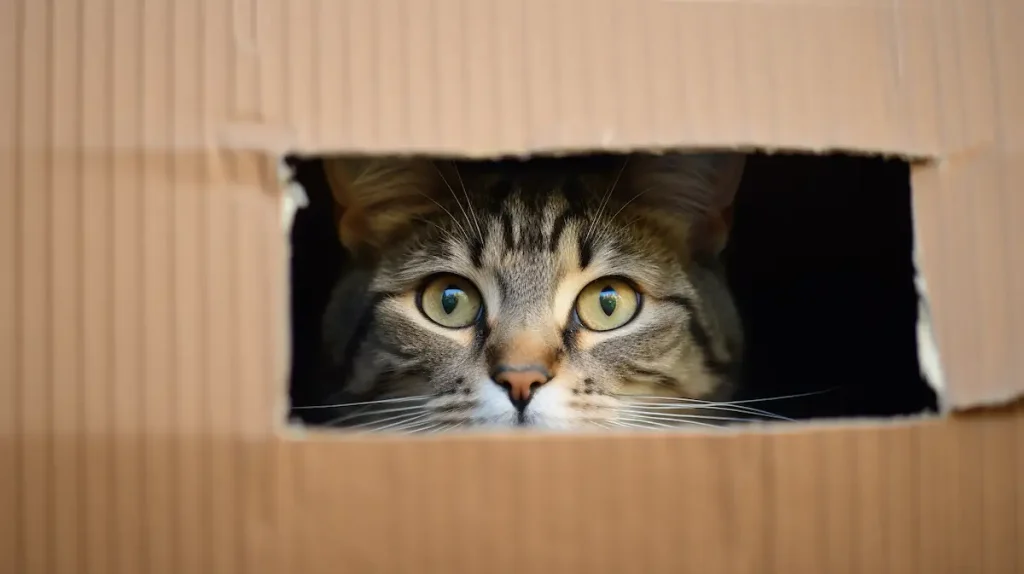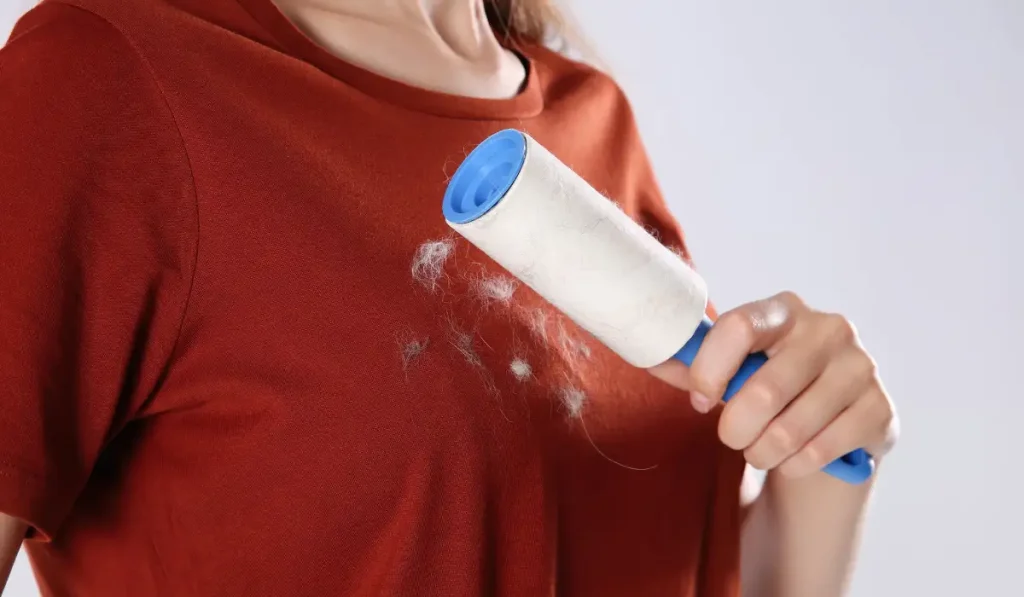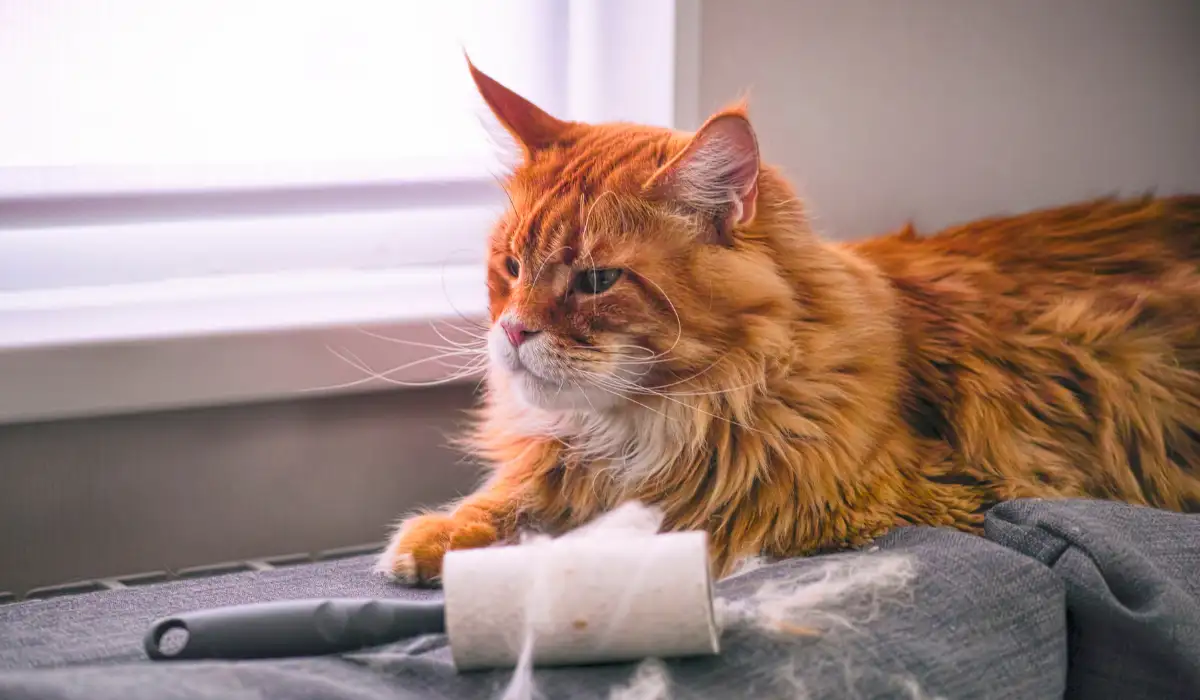Shedding is a natural part of a cat’s hair growth cycle. As cats shed their old, dead hairs, it makes room for new fur to grow in.
While you can’t completely stop your cat from shedding, there are steps you can take to reduce the amount of loose fur floating around your home.
Let’s explore the main causes of cat shedding and provide tips to help control it through diet, grooming, environmental changes, and seasonal care.
We’ll cover topics like:
- The impact of nutrition on your cat’s coat health
- Effective grooming tools and techniques
- Creating a stress-free environment
- Managing heavier seasonal shedding
- When to seek veterinary advice
Follow these practical suggestions to keep your home and clothes fur-free, while keeping your cat’s coat lush and healthy.
A little extra care goes a long way in managing cat fur!
Contents
Diet
What your cat eats can have a big influence on the amount of shedding. Feeding a high-quality diet designed for your cat’s needs provides vital nutrients that support skin and coat health.
Certain nutrients are especially beneficial for reducing shedding:
- Omega-3 and omega-6 fatty acids – Found in fish, fish oils, and plant sources like flaxseed. These healthy fats nourish your cat’s skin and hair follicles.
- Zinc – Supports hair growth and skin health. Look for cat foods with meat meals as the first ingredient to provide natural zinc sources.
- Vitamin E – An antioxidant that helps protect skin cells from damage. Plant oils are a good source of vitamin E.
- Protein – Needed to produce keratin for healthy hair. Make sure your cat food has at least 25-30% protein from quality animal sources.
When shopping for cat food, look for natural ingredients with added fatty acids, antioxidants, and high-quality animal proteins.
Avoid fillers like corn, wheat, and soy. Supplements like fish oil or vitamin E may provide added support, but check with your vet first.
Grooming
Regular grooming is essential for controlling cat shedding. Brushing helps remove loose, dead hairs from your cat’s coat before they have a chance to fall off on your furniture and clothes.Use grooming tools suited to your cat’s coat length and thickness:
- Slicker brush – For short to medium coats. The fine, wire bristles remove dead hairs caught in the topcoat.
- Undercoat rake – For long and thick double coats. The hooked metal tines comb through the dense undercoat to remove loose fur.
- Comb – For long, fine coats. Start with a wide-tooth comb and move to a finer one to smooth and detangle.
- Deshedding tool – For heavy shedders. The serrated edges help pull out loose undercoat fur.
When brushing:
- Be gentle and don’t forcefully tug at mats.
- Brush in the direction of hair growth to avoid irritation.
- Focus on areas prone to tangles like the belly, behind the legs, and base of the tail.
- Increase brushing during seasonal shedding periods.
Regular baths can also help remove excess fur. Bathe your cat every 4-6 weeks or as needed using cat-safe shampoos.
The water pressure helps loosen dead hairs so they can be brushed out easier.
Environmental Control

Your cat’s environment can also influence shedding. Stress and anxiety can increase hair loss and skin irritation.
Here are some tips to create a calmer environment and reduce shedding:
- Maintain a predictable routine for feeding, playtime, grooming, etc. Cats thrive on consistency.
- Minimize changes to their environment like rearranging furniture or introducing new pets.
- Provide hiding places like cardboard boxes and high perches so they can observe from a safe vantage point.
- Use synthetic pheromone sprays and diffusers to help relieve stress. These mimic natural cat pheromones and create a sense of calm.
- Limit interactions with outdoor cats. Seeing other cats outside windows or doors can cause territorial anxiety.
- Consider adding a second litter box if you have multiple cats. This prevents competition for resources.
- Schedule play sessions to help your cat burn off energy and feel mentally stimulated.
When cats feel safe and relaxed at home, their bodies produce less cortisol – the stress hormone.
This helps reduce excessive grooming, skin irritation, and unnecessary shedding caused by anxiety.
Seasonal Changes
As the seasons change, many cats undergo heavier shedding periods. This is natural as their coats adapt to temperature changes:
- In the spring and summer, cats shed their thicker winter coats to make way for a lighter one.
- In fall and winter, they shed their summer coats to grow in a warmer winter one.
During these seasonal shifts, you may notice more loose fur around the home. To help manage heavier shedding:
- Brush more frequently – at least 2-3 times per week.
- Bathe your cat regularly to remove excess fur.
- Consider a “lion cut” for long-haired cats – shaving the body while leaving fur on the legs, tail, and head. This prevents mats and overheating.
- Use deshedding tools to remove loose undercoats.
- Vacuum and lint roll frequently to stay on top of stray fur.
- Limit petting and brush outdoors to prevent fur from blowing back inside.
With extra grooming attention during seasonal changes, you can keep shedding under control even during heavy molting periods.
When to See the Vet
While shedding is normal, excessive hair loss can sometimes indicate an underlying medical issue. See your vet if you notice any of the following:
- Sudden, dramatic increases in shedding with bald patches appearing
- Hair loss focused on a particular body part or only on one side
- Brittle, broken hairs or a dull, dry coat
- Red, inflamed, or irritated skin
- Increased licking, scratching, or overgrooming
- Changes in appetite or activity levels
Excessive shedding can be a sign of:
- Skin infections or parasites like mange
- Allergies to food or environmental triggers
- Stress disorders like feline hyperesthesia syndrome
- Endocrine disorders like thyroid disease
- Autoimmune diseases
Your vet can help diagnose the cause and recommend tailored treatment options like medications, supplements, or allergen avoidance.
Addressing any underlying condition will help get shedding under control.
Keeping Fur in Check

While you can’t completely eliminate shedding, you can reduce the amount of loose fur in your home. Focus on nourishing your cat’s coat from the inside out with a healthy diet containing omega fatty acids, vitamins, and quality proteins.
Groom frequently and thoroughly with the right tools to remove dead hairs before they fall off. Create a calm environment and stick to a predictable routine. Manage seasonal coat changes with extra brushing and bathing.
And see your vet if shedding becomes excessive.With some extra attention to nutrition, grooming, and care, you can keep your clothes and home fur-free while maintaining your cat’s natural shedding cycle.
A little consistency goes a long way in managing cat fur and enjoying cuddle time without a furry outfit to match!
Frequently Asked Questions
How often should I brush my cat?
For short-haired cats, aim to brush at least 2-3 times per week. Long-haired cats need daily brushing. Brush more frequently during heavy shedding seasons.
What is the best brush for cats?
Slicker brushes work well for short coats. Undercoat rakes are ideal for thick, long coats. Start with a wide-tooth comb and move to a finer one for silky coats.
Should I bathe my cat to reduce shedding?
Occasional baths can help remove excess dead fur. Bathe cats every 4-6 weeks using gentle, cat-safe shampoos. Avoid over-bathing which can dry out their skin.
What causes seasonal shedding in cats?
As daylight hours and temperatures change, cats shed their old coats to adapt to the new season. This natural molting results in heavier shedding during spring and fall.
How can I reduce shedding during seasonal changes?
Brush more often, bathe regularly, use deshedding tools, and vacuum frequently. Consider a lion cut for long-haired cats. Limit time outdoors to avoid fur blowing back inside.
When should I see a vet for excessive shedding?
Consult your vet if shedding seems abnormal – dramatic increases, bald patches, skin irritation, etc. It may indicate an underlying medical condition requiring treatment.


